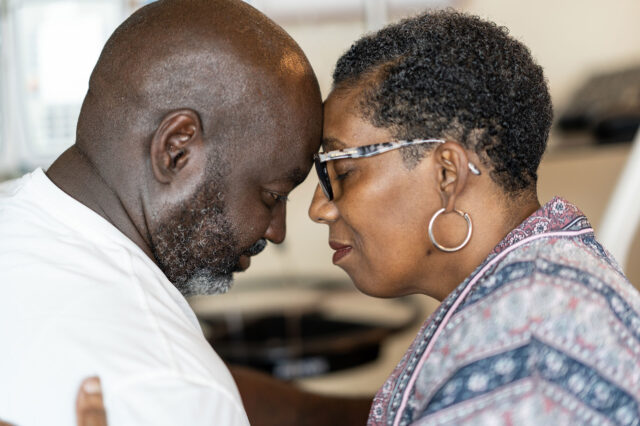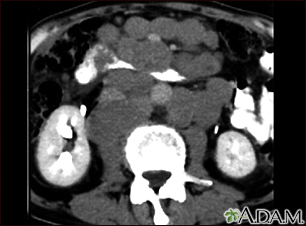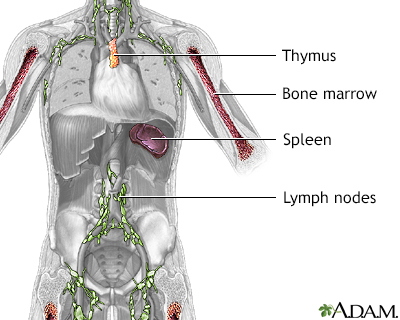The Ride of Her Life
Sandra Davis-Quinney has met bumps, curves and stops on her cancer journey. Even with the rough roads she’s traveled, Sandra tries to remain hopeful,…

Update your location to show providers, locations, and services closest to you.
Non-Hodgkin lymphoma (NHL) is cancer of the lymph tissue. Lymph tissue is found in the lymph nodes, spleen, and other organs of the immune system.
White blood cells, called lymphocytes, are found in lymph tissue. They help prevent infections. Most lymphomas start in a type of white blood cell called the B lymphocyte, or B cell.
Lymphoma - non-Hodgkin; Lymphocytic lymphoma; Histiocytic lymphoma; Lymphoblastic lymphoma; Cancer - non-Hodgkin lymphoma; NHL
For most people, the cause of NHL is unknown. But lymphomas may develop in people with weakened immune systems, including people who have had an organ transplant or people with HIV infection.
NHL most often affects adults. Men develop NHL more often than women. Children can also develop some forms of NHL.
There are many types of NHL. One classification (grouping) is by how fast the cancer spreads. The cancer may be low grade (slow growing), intermediate grade, or high grade (fast growing).
NHL is further grouped by how the cells look under the microscope, what type of white blood cell it originates from, and whether there are certain DNA changes in the tumor cells themselves.
Symptoms depend on what area of the body is affected by the cancer and how fast the cancer is growing.
Symptoms may include:
The health care provider will perform a physical exam and check body areas with lymph nodes to feel if they are swollen.
The disease may be diagnosed after biopsy of suspected tissue, usually a lymph node biopsy.
Other tests that may be done include:
If tests show you have NHL, more tests will be done to see how far it has spread. This is called staging. Staging helps guide future treatment and follow-up.
Treatment depends on:
You may receive chemotherapy, radiation therapy, or both. Or you may not need immediate treatment. Your provider can tell you more about your specific treatment.
Radioimmunotherapy may be used in some cases. This involves linking a radioactive substance to an antibody that targets the cancerous cells and injecting the substance into the body.
A type of chemotherapy called targeted therapy may be tried. It uses a drug to focus on specific targets (molecules) in or on cancer cells. Using these targets, the drug disables the cancer cells so they cannot spread.
High-dose chemotherapy may be given when NHL recurs or fails to respond to the first treatment administered. This is followed by an autologous stem cell transplant (using your own stem cells) to rescue the bone marrow after the high-dose chemotherapy. With certain types of NHL, these treatment steps are used at first remission to try and achieve a cure.
Blood transfusions or platelet transfusions may be required if blood counts are low.
You and your provider may need to manage other concerns during your leukemia treatment, including:
You can ease the stress of illness by joining a cancer support group. Sharing with others who have common experiences and problems can help you not feel alone.
Low-grade NHL often cannot be cured by chemotherapy alone. Low-grade NHL progresses slowly and may take many years before the disease gets worse or even requires treatment. The need for treatment is usually determined by the type of lymphoma, symptoms, and how fast the disease is progressing.
Chemotherapy may cure many types of high-grade lymphomas. If the cancer does not respond to chemotherapy, the disease can cause rapid death.
NHL itself and its treatments can lead to health problems. These include:
Keep following up with a provider who knows about monitoring and preventing these complications.
Call your provider if you develop symptoms of this disorder.
If you have NHL, call your provider if you experience persistent fever or other signs of infection.


Abramson JS. Non-Hodgkin lymphomas. In: Niederhuber JE, Armitage JO, Kastan MB, Doroshow JH, Tepper JE, eds. Abeloff's Clinical Oncology. 6th ed. Philadelphia, PA: Elsevier; 2020:chap 103.
National Cancer Institute website. Adult non-Hodgkin lymphoma treatment (PDQ) - health professional version. www.cancer.gov/types/lymphoma/hp/adult-nhl-treatment-pdq. Updated January 18, 2022. Accessed June 8, 2022.
National Cancer Institute website. Childhood non-Hodgkin lymphoma treatment (PDQ) - health professional version. www.cancer.gov/types/lymphoma/hp/child-nhl-treatment-pdq. Updated April 1, 2022. Accessed June 8, 2022.
Our community and patient programs provide great value to patients, families and loved ones. People can find support, educational materials, expert consultants and more. In most instances, these programs are offered free of charge.
Pain management treatment plans for cancer patients.
Sandra Davis-Quinney has met bumps, curves and stops on her cancer journey. Even with the rough roads she’s traveled, Sandra tries to remain hopeful,…

Summer is fast approaching, and with it comes sunburn season. For some people, however, avoiding a sunburn is more than just a passing thought on the way to…

You might think the only risk from hair dyes would be telltale...